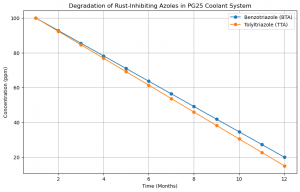In the high-stakes world of AI and HPC data centers, thermal management is mission-critical. As liquid cooling becomes the standard for managing heat in dense compute environments, the health of the coolant—particularly PG25-based formulations—plays a pivotal role in system reliability and performance. But like any fluid, coolants degrade over time. Understanding the science behind this degradation and how to detect it early is essential for maintaining uptime and optimizing operational efficiency.
🧪 What Is Coolant Degradation?
Coolant degradation refers to the chemical and physical changes that occur in a coolant over time, reducing its effectiveness in transferring heat and protecting system components. In PG25 (propylene glycol 25%) coolants, degradation can manifest as:
- pH shifts (acidification or alkalization)
- Oxidation of glycol leading to organic acid formation
- Contaminant buildup (e.g., metal ions, particulates)
- Microbial growth in poorly maintained systems
- Color changes indicating chemical breakdown or contaminant buildup
- Depletion of corrosion inhibitors, especially azole-based rust inhibitors
These changes can compromise thermal conductivity, increase corrosion risk, and ultimately lead to system failure if left unchecked.
🔬 What Causes Coolant Degradation?
Several factors contribute to the degradation of PG25-based coolants:
1. Thermal Stress
Repeated heating and cooling cycles accelerate chemical reactions within the coolant, especially oxidation of glycol, which produces acids that lower pH and corrode system components.
2. Contamination
Ingress of air, water, or particulates introduces oxygen and ions that catalyze degradation. Leaks or improper handling can exacerbate this issue.
3. Microbial Activity
In systems where biocides are not properly maintained, bacteria and fungi can thrive, producing biofilms and organic acids that degrade coolant quality.
4. Additive Depletion
Coolants contain corrosion inhibitors and stabilizers that degrade over time. Once depleted, copper based cold plates become susceptible to corrosion.
5. Degradation of Rust-Inhibiting Azoles
Azoles—such as benzotriazole (BTA) and tolyltriazole (TTA)—are commonly used in PG25 coolants to protect copper and other metal surfaces from corrosion. These compounds form a protective film on metal surfaces, preventing oxidation and pitting.
However, over time, azoles degrade due to:
- Thermal oxidation at elevated temperatures
- Reaction with oxidized glycol byproducts, which can break down the azole ring structure
- Microbial metabolism, where certain bacteria consume azoles as a carbon source
As azoles degrade, their concentration drops, weakening the protective film and exposing metal surfaces to corrosion. This can lead to copper leaching, discoloration, and eventual system failure.

Spectrophotometric analysis can detect the loss of azoles by monitoring changes in absorbance. These changes signal that coolant replacement or reconditioning is needed.
🧭 How Can Coolant Degradation Be Detected?
Traditional methods of coolant analysis involve manual sampling and lab testing, which are time-consuming and reactive. However, modern approaches—like CoolView—enable real-time, non-invasive monitoring using spectrophotometry.
🔍 Spectrophotometric Detection
Spectrophotometry measures how much light a fluid absorbs at specific wavelengths. As coolant degrades, its optical properties change due to:
- Color shifts from oxidation or contamination
- Turbidity from particulates or microbial growth
- Absorbance peaks indicating chemical byproducts from the consumption or degradation of rust inhibitors
By continuously analyzing these spectral signatures, CoolView can detect early signs of degradation, enabling predictive maintenance and avoiding costly downtime.
📈 The Benefits of Early Detection
- ✅ Extend coolant life through timely intervention
- ✅ Prevent corrosion and system damage
- ✅ Reduce unplanned downtime
- ✅ Optimize thermal performance
- ✅ Enable data-driven maintenance schedules
🧠 Final Thoughts
Coolant degradation is inevitable—but system failure doesn’t have to be. By understanding the science behind degradation and leveraging advanced detection tools like CoolView, data center operators can stay ahead of the curve, ensuring their cooling systems remain efficient, reliable, and resilient.
📚 References
